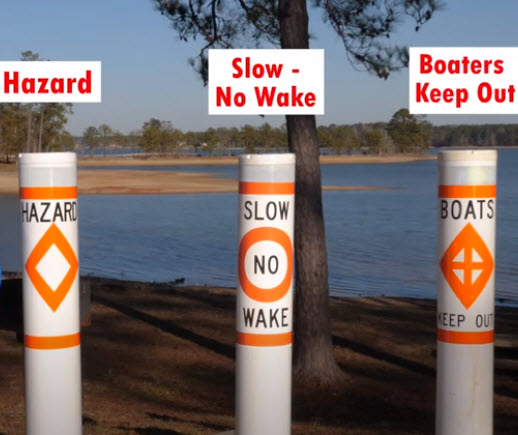While we all want to be out enjoying Lake Martin to the fullest, the most important thing is to learn how to do that safely. Lake Martin is unique in the fact that we have a very special group of volunteers from a non-profit group called Lake Martin Resource Association, but most of the locals around here just call them LMRA. Many of the locals around here are actually members too. The cost of the buoys are covered by membership dues and renewals, plus kind donations.
They tirelessly work to make sure buoys are strategically placed in areas where you want to be careful. Right now there are more than 400 buoys that they maintain. You can see a map of all of the buoys on Lake Martin here. It takes a village, but the members who help financially and the volunteers who are maintaining the buoys all serve an important role in our main goal-to keep you safe while you are visiting us at Lake Martin.
Hazard Buoys

Hazard buoys have an orange diamond on a white background. Most of these are 6 feet tall and are anchored by stainless steel cable and 100 pound concrete anchors. Some hazards are also marked by a pole marker with similar orange and white markings. Be on the lookout for hazard buoys, because these mark underwater obstructions that you may not see from the surface. It could be a rock, stump, sunken object, or underwater shoal. Just because you don’t see it, doesn’t mean that it can’t be harmful to you.
Stay atleast 100 feet away from these and don’t go between two hazard buoys that are within 200 feet of each other. If you see buoys that are within 100 feet of the shoreline, this means that there are shallow waters or hazards between the buoy and the shore, and boaters should not enter into that area.
LMRA tries to identify all hazards at elevation 482 feet msl or higher. These hazard buoys are placed as close as possible to the highest point of the hazard. 33% of the hazard buoys on the lake are lighted. Those you can see from a mile away, and that is great. However, Lake Martin is a very big lake, and these do not cover the whole lake. Even the buoys that you see clearly during the day can be harder to see at night. We don’t advise boating in the dark, especially if you don’t know the lake.
Other Buoys

You will also see buoys with an orange circle. Those are the Slow-No Wake buoys. There are also buoys with a diamond and cross in the middle that are used to alert boaters to keep out of a certain area. To learn more about the different buoys, you can check out LMRA’s buoy safety video here.
What To Do If You Hit A Buoy Or See A Damaged Buoy

Sometimes buoys move away from the hazard they are marking, or get damaged. We hope that you exercise caution and never hit a buoy. When you are in those areas, the threat of the hazard is worse than the damage that the buoy will do to you or your boat. Accidents do happen though. If you do damage a buoy, we ask that you please report it so that it can be replaced, and the next boater is not at risk because of the damaged buoy. Don’t be embarrassed, and please do the right thing and let LMRA know about it so that it can be fixed or replaced.
Even if you don’t hit it, but you are out boating and see a buoy that has been damaged, or has moved away from its intended position, please take a moment and report that also. That one small step could save the life of another boater.
Contact information for LMRA is listed on the buoys, but you can also go ahead and save it in your phone. That number is 256-212-1422. You can also email them at [email protected]. All buoys have identifying letters and numbers that identify that particular buoy and its specific GPS location. They will need this info so they can get the buoy back to where it is supposed to be. You can get more information about reporting a buoy here.
We thank you in advance for paying attention to the buoys while you are out on the water. The goal of Lake Martin Resource Association is to keep you safe, so that you can come back to see us at Lake Martin again and again for years to come.
For more information on boating safety on Lake Martin, check out: Do You Need A Boating License In Alabama and Boating Safety 101: Tips for a Safe Day of Boating on Lake Martin

